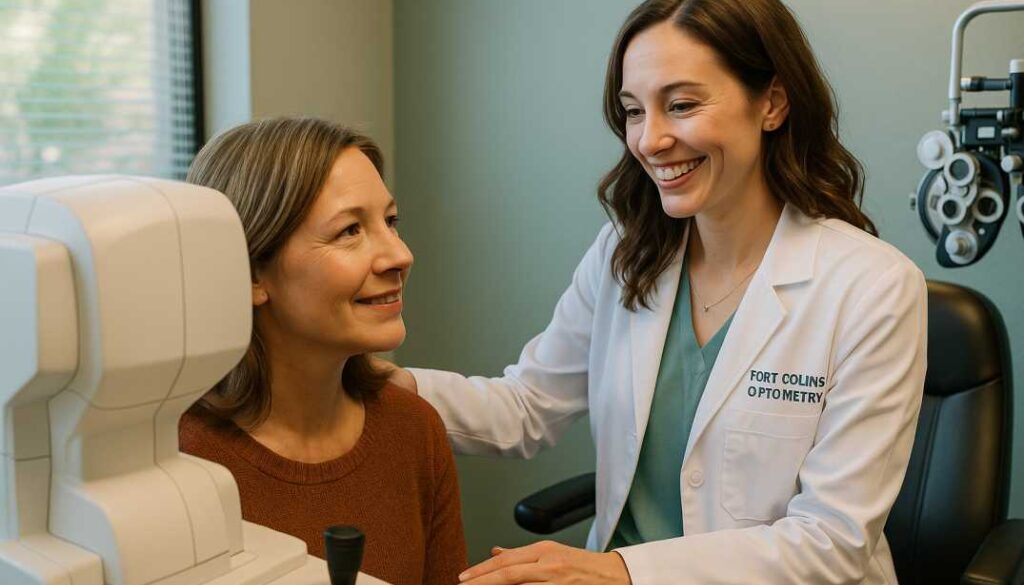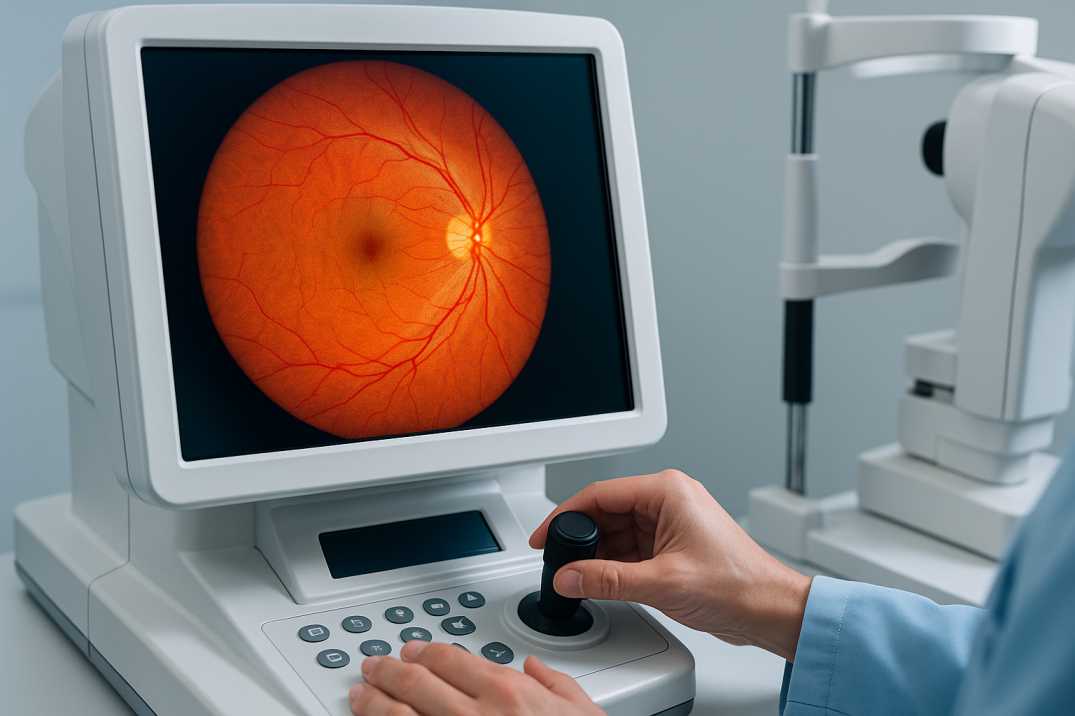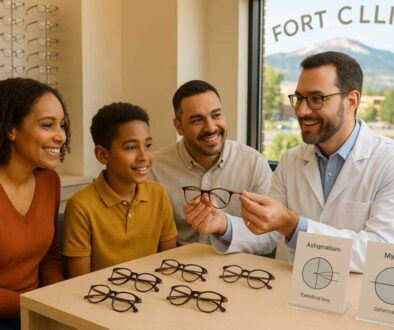Annual Eye Exams: Essential Even With Perfect Vision
The Hidden Truth About “Perfect” Vision
You read the bottom line on the eye chart without hesitation. Your vision seems crystal clear. You might think, “Why would I need an annual eye exam if I can see perfectly fine?”
Here’s what we’ve learned from over 25 years of serving Fort Collins families: Having 20/20 vision doesn’t guarantee your eyes are healthy. In fact, many serious eye conditions develop silently, showing no symptoms until significant—and sometimes irreversible—damage has occurred.
Think of annual eye exams like routine maintenance for your car. You wouldn’t skip oil changes just because your engine sounds fine, right? Your eyes deserve the same proactive care.
Understanding What 20/20 Vision Really Means
Let’s clear up a common misconception. When we say you have 20/20 vision, we’re measuring visual acuity—your ability to see clearly at 20 feet. This measurement only tells us about the sharpness of your central vision. It doesn’t reveal anything about:
- Eye pressure (a key indicator of glaucoma)
- The health of your retina and blood vessels
- Early signs of cataracts or macular degeneration
- How well your eyes work together as a team
- Your peripheral vision
- Your color perception
- Signs of systemic diseases like diabetes or high blood pressure
Here’s the reality: Only about 35% of adults have natural 20/20 vision without glasses, contact lenses, or corrective surgery. But even if you’re in that minority, your eyes need regular professional evaluation to stay healthy for life.
The Silent Threat: Eye Diseases Without Symptoms
Why Early Detection Changes Everything
Many sight-threatening conditions develop gradually, without any warning signs. By the time symptoms appear, the damage may already be permanent. Annual eye exams act as your first line of defense, catching problems at their most treatable stages.
Glaucoma: The Sneak Thief of Sight
Glaucoma damages your optic nerve by increasing pressure inside your eyes. Most people experience no pain or symptoms in the early stages. The disease progresses so slowly that many people don’t notice vision loss until significant damage has occurred—often losing peripheral vision without realizing it.
During a comprehensive eye examination, we measure your eye pressure and examine your optic nerve—often detecting glaucoma years before it would cause noticeable vision loss. When caught early, treatments can slow or stop the progression, preserving your sight.
Macular Degeneration: A Growing Concern
Age-related macular degeneration (AMD) is a leading cause of vision loss in Americans over 50. Early-stage dry AMD often has no symptoms, yet your eye doctor can spot the telltale yellowish deposits (drusen) beneath your retina during a dilated exam.
What is the difference between early and late detection? Early diagnosis and appropriate treatment can help slow or prevent further vision loss, protecting your sight for years to come.
Diabetic Retinopathy: The Hidden Complication
Even if you’re managing your diabetes well, high blood sugar can silently damage the blood vessels in your retina. Remarkably, diabetic retinopathy is one of the most preventable causes of vision loss, with early detection and treatment preventing or delaying blindness in 90% of people with diabetes.
The cruel irony? You can have perfect vision and active diabetic retinopathy simultaneously. Only a comprehensive eye exam with retinal imaging can reveal what’s happening behind the scenes. With early detection and timely treatment, vision loss from diabetic retinopathy can be prevented or significantly reduced by more than 90%. Our specialized diabetic eye care services include advanced retinal imaging to monitor your eye health.
Cataracts: More Than Just an Aging Issue
While cataracts typically develop slowly over years, some forms progress rapidly. Early detection allows us to monitor changes and recommend surgery at the optimal time—before cataracts significantly impact your daily life.
Your Eyes: Windows to Your Overall Health
One of the most fascinating aspects of comprehensive eye exams is what they reveal about your general health. Your eyes are the only place in your body where doctors can directly view blood vessels and nerve tissue without surgery.
During routine exams, we regularly detect early warning signs of:
Diabetes
Changes in your retinal blood vessels—such as leakage, swelling, or a yellowish color—can indicate diabetes even before it shows up in blood work. We’ve helped countless patients catch diabetes early through eye exams, allowing them to begin treatment before serious complications develop.
High Blood Pressure (Hypertension)
Narrowed arteries, unusual bends or crimps in blood vessels, or slight swelling in the eye can all signal elevated blood pressure. These changes may be visible years before hypertension causes other symptoms.
High Cholesterol
Small plaque deposits in your retinal blood vessels can indicate cholesterol buildup in your arteries—a risk factor for heart attack and stroke. We’ve referred many patients for cardiovascular evaluation based on what we saw during their eye exams.
Autoimmune Disorders
Conditions like rheumatoid arthritis, lupus, and multiple sclerosis often affect the eyes. Inflammation, unusual eye dryness, or optic nerve changes can be early indicators of these systemic diseases.
Thyroid Disease
Protruding eyeballs or retracting eyelids may signal thyroid dysfunction. Catching these signs early leads to faster diagnosis and treatment.
Certain Cancers
Though rare, melanoma can develop inside the eye and may be detected during routine examination—potentially life-saving information.
What Makes a Comprehensive Eye Exam Different
Many people confuse vision screenings—like the eye chart test at the DMV or school—with comprehensive eye exams. They’re not the same thing.
Vision screenings are quick checks that can miss up to one-third of vision problems. They create a false sense of security, leading people to believe their eyes are fine when underlying conditions may be brewing.
Comprehensive eye exams at Poudre Valley Eyecare include:
Medical and Vision History Review
We discuss your overall health, family history of eye disease, medications, lifestyle factors, and any vision concerns—building a complete picture of your eye health risks and needs.
Visual Acuity and Refraction Testing
Yes, we’ll have you read the eye chart—but this is just the beginning. We’ll determine if you need corrective lenses and ensure your current prescription is optimal.
Eye Muscle and Coordination Assessment
We evaluate how well your eyes move, focus, and work together. Problems here can cause headaches, eye strain, and reading difficulties.
Pupil Response and Peripheral Vision Testing
These tests check your neurological function and detect early signs of conditions affecting your visual field.
Dilated Eye Examination
After applying dilating drops, we use specialized equipment to examine your retina, optic nerve, and blood vessels in detail. This is when we can detect the most serious eye diseases and systemic health conditions.
Intraocular Pressure Measurement
We check the pressure inside your eyes to screen for glaucoma—a painless process using either a gentle puff of air or a brief touch with a specialized instrument.
Advanced Imaging (When Needed)
Technologies like optical coherence tomography (OCT) and digital retinal photography provide detailed 3D images of your eye’s internal structures, enabling earlier and more accurate diagnosis.
Who Needs Annual Eye Exams?
Everyone—But Especially These Groups
Children and Teens
Good vision is essential for learning and development. Annual exams ensure problems don’t interfere with school performance, sports, and social development. Many children don’t realize they have vision problems because they think everyone sees the same way they do.
Adults 18-39
Even if you have perfect vision, annual exams establish a baseline and catch early signs of eye disease. This is particularly important if you have risk factors like diabetes, a family history of eye disease, or high screen time.
Adults 40-64
This is when age-related changes begin. Presbyopia (difficulty focusing up close) typically starts around 40, and your risk for glaucoma, cataracts, and AMD increases. Annual exams are crucial for catching problems early when treatment is most effective.
Seniors 65+
Medicare beneficiaries and active seniors face the highest risk of chronic eye conditions. Annual exams help maintain independence through early detection and management of age-related eye diseases.
High-Risk Groups
You need more frequent monitoring if you:
- Have diabetes or high blood pressure
- Wear contact lenses
- Have had eye surgery or injury
- Work in visually demanding or hazardous occupations
- Have a family history of eye disease
- Are of Black or Hispanic descent (higher glaucoma risk)
- Are you taking medications that can affect vision
Real Stories: The Difference Early Detection Makes
Throughout our 25 years serving Fort Collins families, we’ve seen how annual eye exams literally save sight—and even lives.
Sarah’s Story: A 35-year-old mother came in for a routine exam with no symptoms. During her dilated exam, we discovered early signs of diabetes through changes in her retinal blood vessels. After we referred her to her primary care doctor, she started treatment immediately—preventing serious complications.
Robert’s Experience: At 58, Robert had perfect vision and felt great. His annual exam revealed elevated eye pressure and early optic nerve changes consistent with glaucoma. With treatment, we’ve successfully maintained his vision and prevented further damage for over a decade.
The Martinez Family: When we examined their 7-year-old daughter, we found significant amblyopia (lazy eye) that school screenings had missed. With early intervention, we successfully improved her vision—something that becomes much harder after age 9.
The Science Behind Annual Eye Exams
Three Recent Studies You Should Know About
Study 1: AI and Early Disease Detection (2024)
Research from Johns Hopkins Children’s Center demonstrates that AI-driven eye exams significantly increase screening completion rates for diabetic eye disease. The study showed that autonomous AI screening using specialized cameras enables accurate diagnosis without the need for pupil dilation or separate specialist visits—potentially revolutionizing access to care.
[Source: Johns Hopkins Medicine, January 2024]
Study 2: Growing Demand for Eye Care (2025)
Research published in Modern Optometry reveals that demand for medical eye care is projected to increase by 31.5% from 2015 to 2025—an additional 16.3 million exams needed annually. This surge is driven by an aging population and increasing prevalence of chronic conditions like diabetes. The message is clear: proactive eye care is more important than ever.
[Source: Modern Optometry, 2019 analysis]
Study 3: Comprehensive Exams vs. Vision Screenings
The American Optometric Association’s Evidence-Based Clinical Practice Guidelines confirmed that even the most sophisticated vision screening tools miss one-third of children with eye or vision disorders. This research underscores that screenings cannot replace comprehensive eye exams for detecting and preventing vision problems.
[Source: American Optometric Association, Evidence-Based Guidelines]
Overcoming Common Barriers to Annual Eye Exams
“I don’t have time.”
We understand—life is busy. That’s why at Poudre Valley Eyecare, we offer flexible scheduling, including evening and weekend appointments. Most comprehensive exams take just 30-45 minutes. Think of it this way: investing less than an hour annually could save you from years of vision loss.
“Eye exams are expensive.”
We accept Medicare and Medicaid because quality eye care should be accessible to everyone. Many vision insurance plans cover annual exams completely. Even without insurance, the cost of prevention is far less than the cost of treating advanced eye disease.
“I’ll wait until I notice a problem.”
This is the most dangerous myth. As we’ve discussed, many serious eye conditions have no symptoms in their early stages. By the time you notice something’s wrong, the damage may be irreversible. Annual exams catch problems before they steal your sight.
“My eyes feel fine.”
Your eyes can feel perfectly fine while serious damage is occurring. Glaucoma, early macular degeneration, and diabetic retinopathy often cause no pain or discomfort until late stages. Comprehensive exams reveal what you can’t feel.
Taking Action: Your Eye Health Roadmap
What to Do Today
-
Schedule your annual eye exam if it’s been more than a year since your last comprehensive exam—even if your vision seems perfect.
-
Know your family history. Ask relatives about eye diseases like glaucoma, macular degeneration, or cataracts. This information helps us assess your risk factors.
-
Maintain a medication list. Bring all current medications to your appointment, even if they seem unrelated to your eyes.
-
Prepare your questions. Write down any vision concerns, no matter how minor they seem.
-
Learn about our services. Explore our comprehensive eye care services to see how we can help your whole family.
Between Exams: Protecting Your Vision Daily
- Follow the 20-20-20 rule for digital eye strain: Every 20 minutes, look at something 20 feet away for 20 seconds.
- Wear UV-protective sunglasses outdoors to prevent cataracts and macular degeneration.
- Eat eye-healthy foods rich in omega-3 fatty acids, leafy greens, and colorful fruits and vegetables.
- Don’t smoke. Smoking dramatically increases your risk of macular degeneration, cataracts, and optic nerve damage.
- Manage chronic conditions like diabetes and high blood pressure—they directly affect your eye health.
- Stay active. Regular exercise improves blood flow to your eyes and reduces disease risk.
The Bottom Line: Your Vision for the Future
Having perfect vision today doesn’t guarantee healthy eyes tomorrow. Annual comprehensive eye exams are your insurance policy against preventable vision loss—and they might just save your life by detecting serious health conditions early.
At Poudre Valley Eyecare, we’ve spent over 25 years building relationships with Fort Collins families, helping them protect their vision across every life stage. From pediatric eye care to comprehensive adult services, from routine exams to managing complex eye diseases—we’re here to be your partners in lifelong eye health.
Remember: Your eyes are irreplaceable. The small investment of time for an annual exam today could mean the difference between clear vision and blindness tomorrow.
Ready to protect your vision? Book your comprehensive eye exam today at our Fort Collins location.
Sources & References
The information in this article is supported by current scientific research and authoritative medical sources:
-
Johns Hopkins Medicine (2024) – “Study Finds AI–Driven Eye Exams Increase Screening Rates for Youth with Diabetes”
https://www.hopkinsmedicine.org/news/newsroom/news-releases/2024/01/study-finds-ai-driven-eye-exams-increase-screening-rates-for-youth-with-diabetes -
American Diabetes Association (2025) – “Retinopathy, Neuropathy, and Foot Care: Standards of Care in Diabetes—2025”
https://diabetesjournals.org/care/article/48/Supplement_1/S252/157552/12-Retinopathy-Neuropathy-and-Foot-Care-Standards -
American Optometric Association – “Evidence-Based Clinical Practice Guideline: Comprehensive Pediatric Eye and Vision Examination”
https://www.aoa.org/healthy-eyes/caring-for-your-eyes/eye-exams
Schedule Your Comprehensive Eye Exam Today
Don’t wait for symptoms. Protect your vision and your health with an annual comprehensive eye exam at Poudre Valley Eyecare. Our experienced team combines advanced diagnostic technology with the personal care you deserve.
Ready to take the next step? Book your appointment online or call our Fort Collins office today. Your future self will thank you.
📞 Call us today | 🗓️ Book online now | 📍 Conveniently located in Fort Collins
Poudre Valley Eyecare: Your trusted partner in lifelong eye health for over 25 years.
FAQs
Please note: None of the above should be considered medical advice. If you’re having any concerns about your vision, please reach out to us immediately or see your primary care provider.





